March 2 - 8, 2014: Issue 152
Arrival of the Mal - 1956 Surf Boards
Avalon Beach Historical Society Meeting of 22nd of February, 2014 Speakers – David Lyall and Bob Head
On Tuesday 25th of February the Avalon Beach Historical Society held a special meeting with Talks given by David Lyall and Bob Head providing some great insights into the ‘Arrival of the Mal’ or Malibu surfboards in Pittwater.
The room was filled with local surfing legends and one of the original Malibus, made from surf board kits for Mal’s created by David Lyall and Doug Jackson, found on a Council ‘chuck-out’ by former Mayor and current Councillor Alex McTaggart, and reconditioned back to former glory by Robbie Newman, was on display. Photographs and clippings from the eras described were available to peruse and part of the Talk given by Mr Lyall included footage compiled by Jack McCoy’s library of surf film.
Later this year will be the 100th Anniversary of Duke Kahanamoku’s demonstration of surfing at Freshwater Beach (either Wednesday 23rd of December or Thursday 24th 1914) – the 24th falling on a Wednesday again this year.
This was the spark that started a large and ongoing fire.
In 1956 a demonstration given by visiting Americans after the Avalon Beach SLSC Carnival on Malibus made the 16 foot long, unwieldy and heavy “Toothpicks” used for surfing prior to seeing these ‘short boards’ seem almost instantly defunct. This demonstration created a new and similar revolution.
Mr Lyall and Mr Head played no small part of this new development, one gentleman developing ways to manufacture the Malibu boards in Australia, the other applying the board to rescue techniques that not only saved lives but attributed to the further development of one of our most iconic pieces of still utilised surf equipment.
Both gentlemen have kindly allowed us to reproduce their addresses from this week. They also inspired us to find a few snippets that offer further insights into this pivotal stage of surfing and surf life saving.
Information about this great local Historical Society and membership are available on their website at: avalonbeachhistory.com.au
1956 – The Arrival of the ‘Mal’
David Lyall:
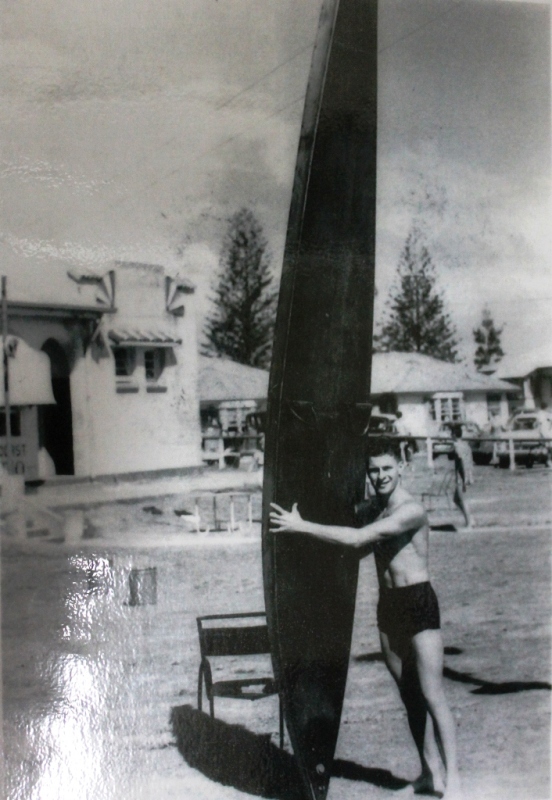 Tonight it will be my pleasure to take you back to 1956 when, following a
Surf Carnival at Avalon Beach, the team from Hawaii put on a display of short
board surfing that promoted the reintroduction and start of the manoeuvrable
short boards throughout the surfing scene of Australia and the world.
Tonight it will be my pleasure to take you back to 1956 when, following a
Surf Carnival at Avalon Beach, the team from Hawaii put on a display of short
board surfing that promoted the reintroduction and start of the manoeuvrable
short boards throughout the surfing scene of Australia and the world.
To set the scene of those early days I have the pleasure to introduce, in the absence of Jack McCoy, one of the most respected surfing cinematographers, some footage not only showing early surfing, but carnivals, boat races, rare footage of the Hawaiian team arriving and board riding in Sydney that Jack has put together for this evening.
(Video was shown here - we have placed links to these in Extras below). Right: David Lyall with one of the surf skis he later built - at Coolangatta.
In 1956 an International and Australian Surf Championship carnival was held at Torquay Beach in Victoria (25th of November and 2nd of December) in conjunction with the 1956 Melbourne Olympic Games. Teams from Great Britain, South Africa, Hawaii, Ceylon, New Zealand and of course many clubs from Australia competed.
As most of the teams arrived and departed from Sydney, Carnivals were arranged at both Maroubra (early November) and at Avalon to be held on Sunday, 18th of November. These were, at the time, the normal Surf Carnivals that had become standard with March Past, R&R, Belt Swim, Swims, Board and Ski races, Boat Races and Beach Events.
At the Avalon Carnival excellent surf was running and after the usual events were completed the Hawaiian team members took their short boards out to the southern end of the beach and had the crowd enthralled for about two hours with their superb wave riding.
Two of the Bilgola Team that had stayed to watch were Doug Jackson (Furniture Manufacture) and myself (Carpenter and Builder) – proudly clutching a hard won ski trophy from that day (David Lyall, along with Peter Howe, were the top ranking ski riders in the area at this time).
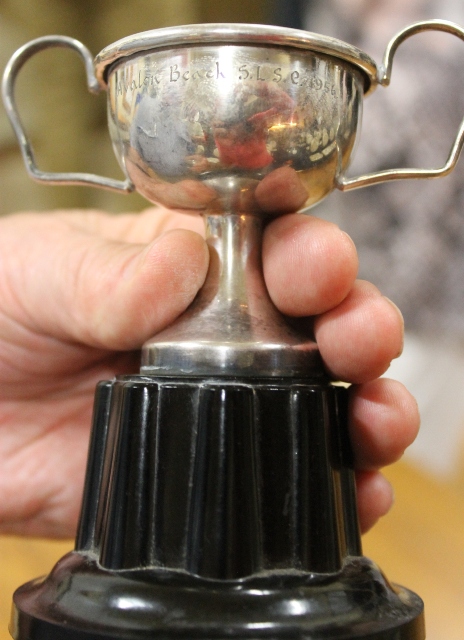
Right: David Lyall's ski trophy from 1956 Avalon Beach SLSC Carnival
A quick look at the shape and dimensions of the visitors boards and it was off to the Jackson Furniture Factory at Newtown after work on the Monday.
After a few experiments, and by working each afternoon after work, two boards were ready for the weekend. These boards were launched at Bilgola and were described by one journalist – Ross Renwick, the founder and mainstay of Billy Blue and a past long-time resident of Avalon as “Looked like and floated like a door.”
The boards were a hollow construction of timber sides, ply frames, plywood top and bottom, timber fin and proved to be a great success. The interest was so great that both boards were sold on the Sunday afternoon at a more than appreciative price.
So back to the factory for Model No 2!!
Soon other boards started appearing from the manufacturers of long boards and skis – Gordon Woods, Bill Wallace, Joe Larkin, all legendary surf board makers, all of the same hollow design.
The design by Jackson and Lyall was modified and each production was tested at the weekends at Bilgola and raised the constant call of “Can I have a lend?” or “How about a go?” from other club members.
It was at this stage the name ‘Okanui’ was given to these particular boards – “out the back” (waiting for the right wave) and I am sure it was Ross Renwick that first used the name.
By now the demand for the boards was so great that Doug and I decided to produce kits – all the timbers and ply cut to size ready for home enthusiasts to prepare, assemble and finish.
This work and the construction of finished boards used up most of the spare time of Doug and myself, with of course the weekends kept free for wave riding. I do recall that two of the kits were successfully assembled by locals – John Wilson, whose wife Alannah may recall the drama of construction, and Tony Clune.
I am also pleased to see that we have one of these kit boards here tonight through the research of Geoff Searl and John and the kind participation of Robbie Newman.
The popularity of the short boards was so great that Surf Clubs showed a marked decline in membership and it wasn’t until the short boards were introduced into SLSA Carnival events that this problem was overcome.
The next evolution was the introduction of balsa wood covered in fibreglass which gave greater scope in shape and design and was accepted by the multitude of builders now trying to satisfy the demanding market. Balsa wood was then superseded by foam with fibreglass covering – a method which has continued until this day.
The final Jackson- Lyall design was put down on paper by me and sold to Build-A Boat plans at Brookvale in 1958.
Doug Jackson and I (David Lyall) were now at the crossroads of whether to continue in the board making business or concentrate on our respective fields. A big factor in the decision was the joys of fibreglass, fumes, dust and associated by-products of surf board manufacture... the decision was made and Doug continued in his family business (Jackson Furniture) and I continued as a local builder. We both continued to build single and double surf skis and competed for Bilgola into the early 1960’s.
I have no idea how many boards or kits were produced and unfortunately neither Doug nor I managed to keep one.
This is a short run down on just one little part of the history of short board surfing and how the “Okanui” came to grace the waves of our peninsula, but I would like to continue with some facts and maybe fiction of board riding from the early 1900’s.
There is a thought that board riding started with the local indigenous people surfing the waves returning from fishing. There is also a story of two brothers ‘borrowing;’ their mother’s ironing board for the joys of catching a few waves.
In December 1914 Duke Paoa Kahinu Mokoe Hulikohola Kahanamoku, at the invitation of Cecil Healy at the 1912 Olympic games, came to Australia and demonstrated board riding at Freshwater; much to the amazement of the locals and even more so in taking “a female’ – Isabel Ltheam, out for a wave.
Earlier claims stem back to the legend Snowy McAlister and Tommy Walk, Snowy claiming Tommy “…was the first man to ride a surf board at Manly Beach..”.
Competition became a big factor in the design of both boards and skis. Surf Club races and Carnivals were basically out through the surf, round the marker buoys and back to the beach, straight paddling all the way. Water dynamics came to the fore and the longer the waterline length, the faster the craft. Consequently Boards and Skis reached massive lengths – 20feet (6 metres) or more with Double skis up to 22 feet (7 metres) and then of course the need to store the craft – so logically you joined and competed with a Surf Club.
The change to short boards and the increase of car ownership saw a complete change to coastal surfing, and, as mentioned, a decline in membership of Surf Clubs. The slides shown here tonight trace some of the events of surf boards on our peninsula and one proves how early surfboard riding started on the peninsula – a photo of Isabel Letham and friend on Bilgola Beach circa 1917. Isabel was the young lady who was taken surfing by Duke Kahanamoku at Freshwater – her father, William Letham helped him make one from a plank of sugar pine purchased from a local hardware store. At Freshwater Beach Kahanamoku gave a 3 hour demonstration of "Hawaiian-style surf shooting" to a crowd of several hundred people.
At the end of the session Kahanamoku invited Letham from the crowd for a tandem surfing demonstration. Letham, 15 at the time, was an accomplished swimmer and bodysurfer, and known as something of a tomboy. On the first few waves they paddled some sources state Isabel yelled for him to stop because “it felt like going off a cliff”. Being a gentleman Kahanamoku did stop, but then ignored her cries, went anyway, and hauled her up. They rode four waves that day and Letham was, as she later said "hooked for life".
_______________________________________________________
Bob Head:
It seems to me that with all entities a common thread exists- that we more often as not identify with themes like ‘the earliest, biggest, oldest...’
One of these fits into ‘the first’ category and is one I’d like to focus on with my journey of the Malibu tonight. I would like to say as a preface that there are more accredited local surfers, such as Mick Dooley, Steve Reynolds, Midget Farrelly and Mr. McKay then I for this gig.
I would also like to say that I have always been both a Clubbie and a boardrider and it is in this context that the following comments are made.
My name is Bob Head – I moved from Gordon in 1944 to Newport and attended Newport Public School. I was a budding swimmer and used to go to The Spit everyday to train with a chap called Harry Hayes.
Life was ghood in those days, you could smell the freshly cut grass from the Victa mowers, everything was great. I joined the Newport SLSC at 12 years of age, got my 16foot ‘Toothpick’ at 14 years of age. At 15 I moved to the Avalon SLSC of which I am a Life Member.
Having seen the film of Duke Kahanamoku visit and its life changing effect on the Surf Life Saving Community and surfing community last century, you would never believed that that could happen again, however, further innovative progress with surf craft went on at a steady pace until one day in 1956 when, for everyone interested in surfing, the world stopped and was never going to be the same again.
Having been in a couple of surf races at the Avalon Surf Carnival of November 18th, 1956, I was in the boat shed at the club with a couple of friends doing our end of carnival tasks. All of a sudden there was a deathly hush and we couldn’t work out what had happened, fearing at first that the worst had happened and there had been an accident. People were running past us, out of the boatshed, down from the sides of the surf clubhouse – we got drawn in and went out and had a look ourselves.
There we saw something that we had never seen before – there were these chaps surfing across the beach – this way, then that way, back and forth – we’d never seen anything like it before.
There is a photograph here that shows those of the Avalon Surf Club who were in that carnival with the American surfers. I’m not in that photograph, and the reason I’m nit in that photo is I ran home to Newport to ask my father for some money to build a surfboard. Not being the artists that David Lyall is, I knocked it up in a few days, took it down to Newport where it immediately sank and it’s still there somewhere. Such were my surfboard manufacturing skills at that stage.
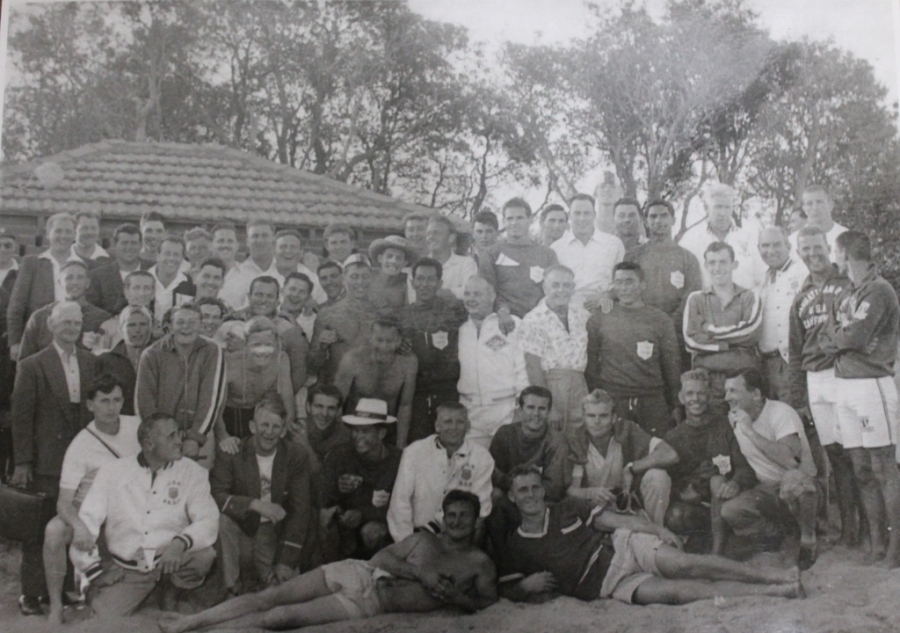
The post-Carnival photograph of Avalon Beach SLSC members and visitors. Courtesy ABHS.
I knew about David Lyall starting to make boards, Ross Renwick, Woods, Bennett, Dillon – all the manufacturers up and down the coast, as well as McDonagh Brothers who owned Barrenjoey Properties - Denis McDonagh was a very prolific manufacturer of surfboards in the early days, and in fact is one of the two brothers who started Surf, Dive and Ski. A lot of that history has been lost or people don’t remember it.
From that day in 1956 on life changed, I use to go to swimming training, that stopped. Girls finished, Elvis was gone, there was a new language and the Beach Boys were on the radio, we were now talking about Okanuis, thew Woodies – people didn’t know what we were talking about or understand what we were doing.
Time went on and for some reason the clubbies and the surfers clashed, and I think it may have been more over safety and territorial issues, at any rate, the divide widened, especially with the Council’s introduction of registration of all surfboards which the surf clubs had a role in policing.
Being affiliated with both camps I decided I better try and do something about it. So along with Mr Sumpter and myself we formed in 1958 what was known as a surfing organisation and started what was then known as the First Malibu Surfing Contest supported by Avalon Beach SLSC – this was certainly the first Malibu surfing contest run in New South Wales, if not within Australia.
Over 200 surfers turned up that day, at which we were quite amazed. The following event was very successful - we had entertainers such as Col Joye presenting trophies and the contest was deemed to be an incredible success. At that time the other issues, as far as the Boardies and Clubbies were concerned, were put on the backburner.
As Mr Ripley would say ‘believe it or not’ I was privileged to be a part of this Malibu phenomena happening again.
In 1962 I went to Newquay in Cornwall along with three friends, Warren Mitchell, John Campbell and Ian Tiley, taking two Malibu’s with us. We got jobs as lifeguards working on remote beaches outside the town. Prior to our arrival some of these remote areas used huge army ducks to perform difficult rescues and these were what we initially used. These we found were not very practical. They had surf lines like we used here but on the occasions when you had nobody to pull you in if you were the lone lifeguard, they would fasten them to jeeps or vehicles and pull you in that way but they would get tangled when pulled over the landscape in this way.
As we went there with double Malibu’s our rescue equipment of choice was these and we performed many rescues just using the Malibu. In this way everyone became aware of the boards versatility.
In the previous year 16 people had been lost. In the years we were there nobody was lost. So this was quite a successful new piece of equipment from the life saving point of view.
I would like to point out here that Warren Mitchell, a favourite son of Avalon, is the gentleman who is responsible for the rubber duckie. He said, when we were using the Malibu for rescues – “Bob we have to do something about this because we can only pick up one or two people” – as over there we at times would have to pick up not just one or two people, but half a dozen people, so Warren was always on the lookout for something different.
That is where the seeds were sown for the rubber duckie.
In our first overseas year off season we toured Europe – we went to Africa, Morocco, France – we surfed everywhere. We also experienced a huge demand for our boards and started making them (see article below). In the United Kingdom, in Cornwall in particular, this had a huge economic impact which before had been dependant on Tin mines and China clay.Surfing is now a billion dollar industry there.
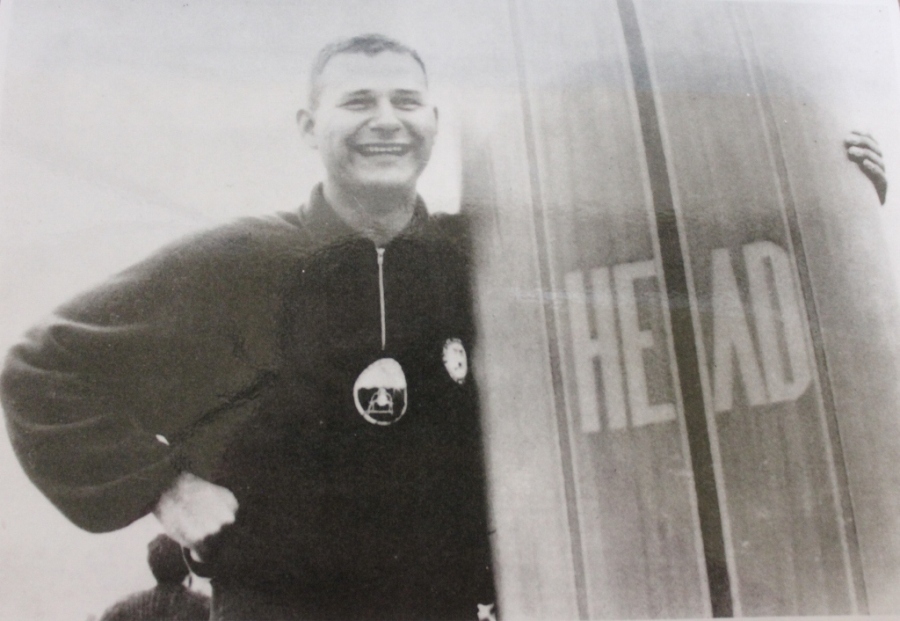
Bob Head with one of his Malibu boards
When I first went to England I had to go by ship. Nowadays planes enable lifeguards to follow the seasons and many ex-Newquay people have ended up in Avalon. One of my early UK Malibu converts Mike Jones, has a son, Stanley, who is now Club Captain of Avalon Beach SLSC.
To me one of the greatest achievements of the development of the Malibu is that it lead to the development of one of the greatest pieces of rescue equipment for surf life saving, that of Warren Mitchell OAM’s rubber duckie which has saved many many lives against all odds.
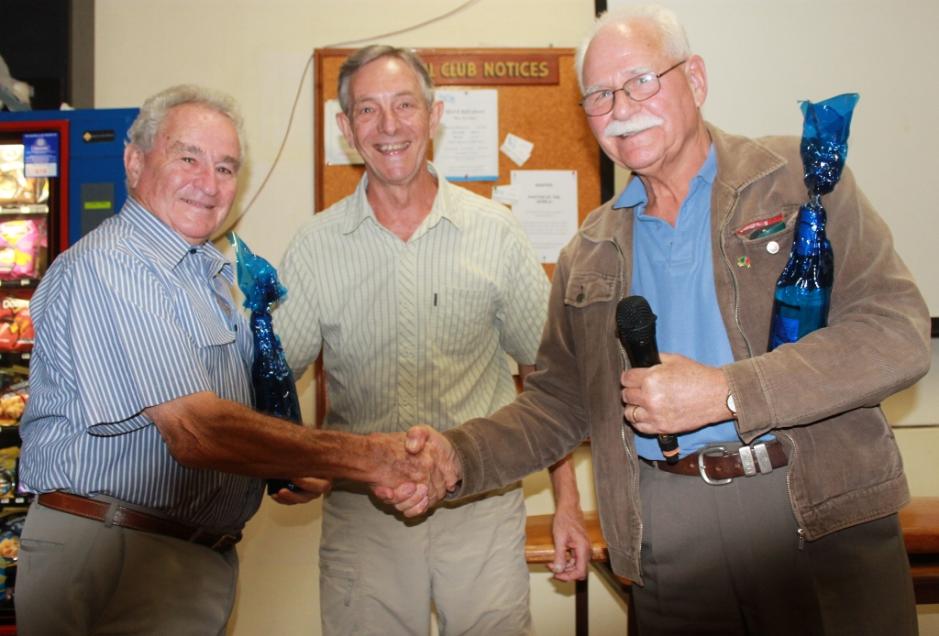
Extras pertaining to these Talks:
"SURFIES" of CORNWALL From KERRY McGLYNN, in London
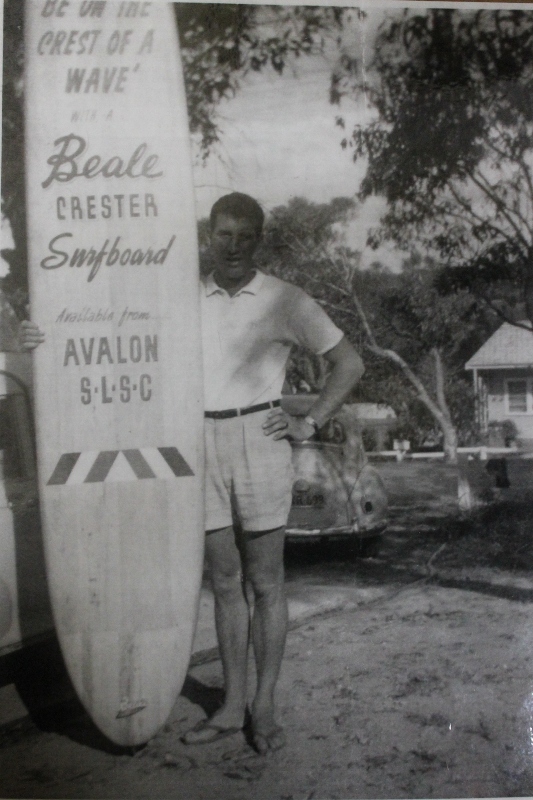 Photos: BOB HEAD, from
Newport, N.S.W., works on a surfboard. He set up the factory and shop at Newquay
with three English partners and sells Malibu boards in England and on the
Continent for well under half the price of the boards imported from
America. AT
RIGHT: Bob Newton, one of the Australians at Newquay, checks Malibu boards for
hire on the beach. Bob, from Balgowlah, N.S.W., has spent the summer as a
lifeguard. The southern end of the beach
was roped off with a warning: "For surfboards only." About a thousand yards out a little knot of board
enthusiasts waited, their legs dangling lazily over the sides of multi-colored
Malibus. They looked every inch the
surfer: tanned, glistening young bodies, rainbow-colored Bermuda shorts,
longhair bleached by the sun and probably just a dash of sink-cleaner. An
everyday sight on Australian beaches. But
these slaves of the surf were not within hotdogging distance of Manly or Bronte
or Cronulla.
Photos: BOB HEAD, from
Newport, N.S.W., works on a surfboard. He set up the factory and shop at Newquay
with three English partners and sells Malibu boards in England and on the
Continent for well under half the price of the boards imported from
America. AT
RIGHT: Bob Newton, one of the Australians at Newquay, checks Malibu boards for
hire on the beach. Bob, from Balgowlah, N.S.W., has spent the summer as a
lifeguard. The southern end of the beach
was roped off with a warning: "For surfboards only." About a thousand yards out a little knot of board
enthusiasts waited, their legs dangling lazily over the sides of multi-colored
Malibus. They looked every inch the
surfer: tanned, glistening young bodies, rainbow-colored Bermuda shorts,
longhair bleached by the sun and probably just a dash of sink-cleaner. An
everyday sight on Australian beaches. But
these slaves of the surf were not within hotdogging distance of Manly or Bronte
or Cronulla.
THEY were at Newquay, on the coast of Cornwall, a quaint little English holiday town that was once a muted outpost of the deckchair and sun hat brigade, who looked on the surf as something to sit by, not swim in. Their tranquil existence has been disturbed by an enterprising band of young Sydney surfboard riders who have turned Newquay into a surfing centre of Europe. The Australian surfing craze is rolling like a Bondi breaker across the pleasure resorts of Europe and North Africa. ….
Right: the 'Crester" - image courtesy Avalon Beach Historical Society.
Aga Khan: His instructors will be Sydney boardriders Rodney Sumpter, 18, of Avalon, and 23-year-old Dennis White, of Collaroy. This surf-mad pair left Australia in January for America, where they tried out their boards on the beaches of Newport, Rhode Island, after a stint in Hawaii. With money running short, they crossed the Atlantic to the island of Jersey, home of a big contingent of Australian surfies. There they took part in the British national and international championships in July. Rodney Sumpter, a lean, lively English migrant who learned all about surfing in Sydney, took off both the national and international titles. Dennis, Sydney-born and bred, was not far behind, and finished fourth on points in the international contest. I spoke to Rodney at Newquay, where he and his blond-headed partner were preparing to leave for France to take part in the French championships. They were waiting for their Australian mate 24year-old Bob Head, of Newport, N.S.W., to finish two new boards for them.
Head, who has lived at Newquay for three years, is the one who has really cashed in on the European surfing boom. He arrived on the Corn-wall coast three years ago with a Malibu board and landed a job as a lifeguard. At that stage, Malibu boards were as scarce in England as boomerangs. Nobody at Newquav had ever seen one before.
"A lot of people didn't even know that you had to take them into the water," Head told
me. "They thought they were something to plonk on the sand and sit on.
"The curiosity was tremendous at first, and it wasn't long before people started asking me to get them boards."
Within two years the small stream of orders trickling in has developed into a tidal
wave. Two years ago Head made ten boards in 12 months. In the past month he has been turning out 20 a week. With three English partners he has set up a factory and a surfing shop in Newquay, and has made Cornwall as proud of its surf-boards as Liverpool is of the Beatles.
"The whole thing is spreading like wildfire," Bob Head said. "We have six people in the factory making surfboards, skateboards, and other beach gear. We have another six in the shop selling them, along with beachwear and all kinds of surfing books and trinkets. On the Continent they've really gone for the boards in a big way. We have an agent who takes them all the time to flog in Europe. We met him about four months ago when we had a stand at the Boat Show in London. He looked our stuff over and took 50 boards on the spot."
Head, who was a sales representative in Sydney, had never made a surfboard before he came to England, and his first, effort was "a bit rough."
He has one Australian working for him; this is Mick Jackman, a 25-year-old ex Sydney photo-engraver. The rest of the factory help are English.
"Mick and I both used to hang around the board shops in Sydney, so we both had a pretty good idea," said Head. "But mostly it's been trial and error. Making surf-boards is a trade of secrets- every bloke has his own techniques and nobody is prepared to give his tricks away, so we have had to find out for ourselves. We have suffered from a shortage of proper materials, particularly good foam, so our boards are not as good as the ones sold around Sydney."
But to compensate, Head's company, European Surfing Co. Ltd., is selling its product at around £30stg. each(an American board costs about £70stg. in Europe).
How quickly are the British and Continental "gremmies" catching on?
"I've been away four months of the past six in Britain and the Continent giving lessons, exhibitions, and demonstrations of all kinds," Head said. "There has been tremendous enthusiasm for board riding everywhere that I've been, and the youngsters seem to pick up the knack fairly well. They are probably a bit slower than Australians, but that's only natural, because they haven't had nearly as much opportunity as the kids back home."
Head rates the Newquay surf the best in Europe "on its day."
"The difference," he said, "is that in Sydney you can surf for maybe two-thirds of the year. Here you are lucky to surf for even a third of the year."
Head is the "elder states-man" - certainly the longest-established member-of the 15-strong Australian surfing community who live in Newquay. Five of these Sydney surf fanatics, Bob ("Nuts") Newton, 26, of Balgowlah, Gary ("Lumpy") Cox, 23, of Harbord, Warren ("Sui") Sullivan, 27, of Warriewood, Noel ( "Yokum" ) Harridine, 28, a former captain of Warriewood Surf Club, and Mick ("The Phantom")Irwin, 25, of Harbord, work as £14-a-week lifeguards on the beaches around Newquay. At nights they serve in a local pub pulling beer. Bob Newton estimates that he makes about £21st g.a week ("enough for a few beers and the birds"). Six of them live in a caravan park and spend all their spare time in the surf. Mick Jackman, known around Newquay as "Shades," earns extra money playing piano in a four piece band at a hotel.
"I'm about to marry an English girl, so I need the money," he said. "I suppose I was earning about £2000 a year in Sydney as a photo-engraver. Now I'm ripping off about £33 a week with two jobs."
Both he and Head are the permanent members of the Australian community, and plan to stay in Newquay for another five years. Head has married an English girl and has a baby son. "The Phantom" is also married. ("These English birds, mate, they are really great," explains Mick Jackman.) The other Australians in Newquay work in pubs or on the beaches or both. They are the idols of dozens of Cornish school-boys, who have given up the Rolling Stones for the rolling surf. Said Dennis Holmes, "I've seen a few English 'gremmies' who look as though they will be real good on the boards."
Rodney Sumpter agreed. "One kid I have seen is going to be a world champion." Sumpter and Holmes are off soon on their sponsored tour which will take them to Sardinia, the Canary Islands, Africa, and Singapore.
"The Aga Khan has offered to put us up in his place at Sardinia for a while if we will give him lessons and demonstrations,” said Sumpter. "I reckon it's going to be pretty outrageous."
"Outrageous" is the surfers' word for "wonderful." ILLUSTRATED. "SURFIES" OF CORNWALL. (1965, October 20). The Australian Women's Weekly (1933 - 1982), p. 22. Retrieved from http://nla.gov.au/nla.news-article57961104
Britannia rides the waves. The centre of the surfing world is Australia according to Australians. Hawaii might be almost non-existent. It is like an ice-water dousing to discover Britain is now on the surfing map as described in this British Travel Association article. Surfers at Newquay, Cornwall's largest resort and Britain's leading surfing centre. It could be Bondi but it's not. British surf teams march past on the sands at Newquay, Cornwall. ALONG the great sandy beaches of south-west England, where the whitecapped breakers come rolling "in majestically from the open Atlantic, the enthusiasts are preparing for another summer of one of the most exhilarating of all sports - riding the waves on surf-boards. It is a sport which can be enjoyed in ideal conditions in Britain, especially on the coasts of Cornwall and Devonshire, where the chief centres include Newquay, Bude, Perranporth, St Ives and Woolncombe, Pembrokeshire and the island of Jersey. Surfing has developed from the early achievements of a few daring swimmers challenging the giant wave crests of the Pacific to a sport engaged in by serious sportsmen in every part of the world where the right conditions present themselves.
Pieces of driftwood and planks of timber formed the primitive makeshift surfboards of the early pioneers, but today the sports stores carry scientifically-designed boards beautifully constructed of Balsa wood, polyuretliane and fibreglass. A modern Malibu board, 8ft long and weighing some 20lb, with its shark-like outline and dorsal fin or "skeg", can cost over £32stg. It is a gaily decorated accoutrement, as finely balanced and streamlined as any hydrofoil.
Big-wave riding originated in the Hawaiian Islands and spread its lure to the United States, to Australia and to those sections of the European coastline which are eternally pounded by the Atlantic rollers. In all these places you will find the "surfies", an almost nomadic body of men who stem from many regions and climes and like the Polynesians of old-seem to spend their lives in a realm of sea spray, sand and sun tan. There is a strong Australian influence on the surfing beaches of Britain.
Even their language is salty. They speak in esoteric terms of .beach and wave profiles; their special vocabulary comprises such expressions as "kick-outs", "cut backs", "hot doggers", "dumpers", "wipe-outs", and "soup-outs". To describe different manoeuvres they will use terms like "on the nose", "walking", and "hanging five or ten", the last being a reference to toes. They are dedicated, athletic men who spend long hours in the sea in the summer months and never really satiate their love of this kind of speed.
They are the perfectionists, to whom those who would emulate them must turn to learn something of their skill - for, make no mistake, real surf-riding is essentially a sport for the skilled. There is one aspect of surfing that may claim to be unique, for this is basically the one sport which embraces within itself highly developed life-saving techniques.
Beachguards - The popularity of riding the big waves has brought into being a number of expertly-trained teams of strong swimmers and beach guards who provide a voluntary protective force wherever the surf runs high around the Atlantic coast resorts. There are now about 30clubs affiliated to the Surf-Saving Association of Great Britain founded in 1955. The surfing contests, carnivals and displays organised at various resorts each summer under the auspices of the association attract large crowds and provide a thrilling spectacle for the holidaymakers on the beaches. Pride of place in the annual calendar goes to the National Surf Championships, which were inaugurated in 1958 at Porthtowan and have been held since then at St. Agnes. Perranporth, Bude, St. Ives and(last year) Newquay.
This year the big event moves out of Cornwall for the first time – to Woolacombe, a small and attractive North Devon resort noted for one of the finest sandy beaches in the country. The championships are spread over two days, and the programme' always opens with the colourful march-past of the 10-man club teams carrying their distinctive pennants. Then follow the various contests (including belt races, ski races, surf races, rescue and resuscitation competitions and the National Board-Riding Championship's), in which purely sporting appeal is intermingled with practical application to life-saving.
The Surf Life-Saving Association has now organised a scheme whereby owners of surf boards, surfskis, canoes, kyaks and small dingies maybe registered as "responsible persons observing the water and beach safety codes and conforming with the wishes of surf life-savers, beachguards and harbour authorities." In addition, two new awards have been devised for non-Association members: a Resuscitation Certificate and a Certificate of Surf Competence. Of course, you need not be an expert to taste some of the simpler joys of surfing. Down on the Atlantic beaches you will see plenty of holiday makers riding the surf for the final few yards of its journey to the shore and being happily deposited on the sand when the wave recedes. That may not be what the experts call surf-riding- but it's good fun all the same. Britannia rides the waves. (1965, July 1). The Canberra Times(ACT : 1926 - 1995), p. 20. Retrieved from http://nla.gov.au/nla.news-article105758580
SURF CLUB FOR BRITISH BEACH - LONDON, Tues (A.A.P.). -Surf life-saving clubs are to be formed at two Cornish beaches where lives have been lost this season. This is the outcome of demonstrations in Australian surf life-saving techniques at Bude, Cornwall, last weekend. The Australians have lent a surf reel, brought to Britain in the Royal liner Gothic, to the councils controlling the two beaches where the clubs are to be formed. The Bude - Stratton Council has presented an illuminated address and silver inkstand to Australian life-saving expert. Photo: Mr. Allan Kennedy, who gave the Bude life-savers their first instruction. ILLUSTRATED SURF CLUB FOR BRITISH BEACH. (1954, September 1). The Mercury (Hobart, Tas. : 1860 - 1954), p. 6. Retrieved February 27, 2014, from http://nla.gov.au/nla.news-article27243127
SUNTANNED, bearded Ross Renwick, of Roseville, N.S.W., who contributed the article opposite on the current hot-doggin' craze, can be found most summer weekends with his balsa board at Bilgola Beach, one of Sydney's northern beaches. Twenty-three-year-old Ross has been riding surfboards himself for seven years; he is looking forward to competing sin the first hot-dog meet of this summer's surf carnival. ILLUSTRATED. The Weekly Round. (1958, December 3). The Australian Women's Weekly (1933 - 1982), p. 2. Retrieved from http://nla.gov.au/nla.news-article48077083
SURF BOARDS PROHIBITED. At the last Meeting of the Waverley Council an application was received from Mr. F. Foran for permission to use a surf board at Bondi. It was decided to Inform the applicant that the practice of surf shooting by means of a surf board was one that should not be encouraged, as It caused Inconvenience and annoyance to the public. The Inspectors were ordered to see that The practice was discontinued. SURF BOARDS PROHIBITED. (1916, April 19). Evening News(Sydney, NSW : 1869 - 1931), p. 6. Retrieved from http://nla.gov.au/nla.news-article115838277
Why are surfboards registered? EVEN though the 5/- registration fee is such a small amount, I still think it fair that we should know for what reason we register our boards. The "boys from the club" had come round the beach to collect fees, and a conversation along these lines followed:
Us: Why do we have to register boards?
Them: You have to register cars for the use of the road, so you register boards for the use of the beach.
Us: But there is a lot of upkeep as far as the use of roads is concerned. What upkeep, apart from cleaning up, is there on the beaches?
Them: You have to have a beach patrol.
Us: Lifesavers patrol the body-surfing area, not the board area. Boardriders if in trouble rely on other riders. Why not make body-surfers pay a registration fee?
Them: If you hit a bodysurfer and your board isn't registered and a lot of damage is caused you can be sued for everything. Whereas, if your board is registered, you have a fair chance of getting off more lightly.
Us: How ridiculous! Whether or not your board is registered isn't going to make any difference in how much they sue you for. Any-way, it's your job to keep body-surfers out of the board area. We manage to keep out of the body area.
We weren't kicking up a fuss about paying the 5/-,we just want to know why. We never did find out. - "Bilgola Bunny," Beecroft, N.S.W. Letters. (1965, December 29). The Australian Women's Weekly (1933 - 1982), p. 48. Retrieved from http://nla.gov.au/nla.news-article51190827
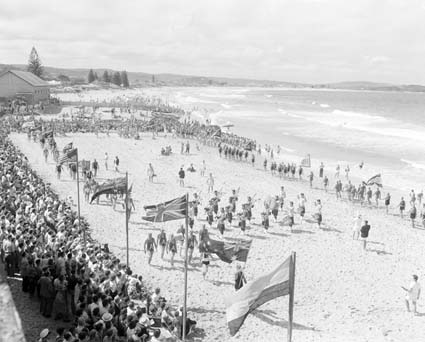 Service in the Sun (1957) - On a beautiful day at Bondi, two
members of the American surf lifesaving team and one from the Hawaiian team take
to the water to show off the latest surfing techniques. They are in Australia
for the 1956 Melbourne Olympics, where surf lifesaving is a demonstration sport.
Hawaiian team manager and surfing legend Dick Kahanamoku watches from the beach,
with the board he made during his first visit to Australia in late 1914. The
Hawaiian and American surfers display technique far beyond anything then known
in Australia. See film at: http://aso.gov.au/titles/sponsored-films/service-in-the-sun/clip1/#
Service in the Sun (1957) - On a beautiful day at Bondi, two
members of the American surf lifesaving team and one from the Hawaiian team take
to the water to show off the latest surfing techniques. They are in Australia
for the 1956 Melbourne Olympics, where surf lifesaving is a demonstration sport.
Hawaiian team manager and surfing legend Dick Kahanamoku watches from the beach,
with the board he made during his first visit to Australia in late 1914. The
Hawaiian and American surfers display technique far beyond anything then known
in Australia. See film at: http://aso.gov.au/titles/sponsored-films/service-in-the-sun/clip1/#
Right: Sport - Surfing - The flags of six different countries flew on Collaroy Beach, near Sydney, during an international surf carnival held during December 1956 - A Scottish pipe band plays during the march past of teams from United States, New Zealand, South Africa, Hawaii, Ceylon, Australia and many New South Wales surf life saving clubs PRINCIPAL CREDIT: photographer J Fitzpatrick, courtesy National Archives of Australia, Image No.: A1200, L22507
Freshwater Surf (1956) - Annual State Surf Championship in progress at Freshwater Bay. LV. Life savers parading on beach. GV. Two crews rowing their boats out to the sea. LV. Single boat making its way out through enormous breakers. GV. Two boats being rode out to sea through a breaker. LV. Crew of boat jumping overboard as they are swamped by enormous waves. LTV. Single boat being swept to a shore with the crew hanging on grimly. GV. Two boats being smothered by big waves showing men in the water. LV. One boat being completely capsized and disappearing in the foam. See film at: http://www.britishpathe.com/video/freshwater-surf/query/swamps
1956 Melbourne Olympics and Surf Carnivals
IF you are within striking distance of Torquay, Victoria's Jewel of surfing beaches, on either of the two Olympic Sundays, you will see an Australian sport at its best. Just 58 miles from Melbourne, 3,000 bronzed athletes of the surf will put on grand displays. Life-savers from all Australian States and many overseas clubs will stage a grand March Past. On November 25 the International Surf Carnival will be held, and on the following Sunday the National Surf Championships. Life-savers will demonstrate rescue methods. Then there is the surfboat race, in which 60 boats will plough out to calmer waters behind the line of breakers to come rocketing in on rolling walls of water. Three hundred surfers will compete In surf ski races.
Overseas competitors - Taking part on both Sundays will be 70 teams from Australia and 70 overseas competitors from Ceylon, South Africa, New Zealand, and Hawaii. Admission to the carnivals at Torquay on both Sundays is 5/ for adults and 3/ for children. Grandstand seats at £2/2/may be reserved by contacting the secretary of the association, Mr. J. Williams, atXB5210 or MU2129. Admission, grandstand reserved seat and rail-bus tickets are now on sale at the Victorian Government Tourist Bureau, 272 Collins st., MF0202.
Here is how to get to Torquay: Special trains leave Flinders st. station at 8.45 a.m. and 8.50 a.m., and arrive at Geelong; at 9.45 a.m. Other trains leave Flinders st. station at 9.20 a.m. and9.25 a.m., arrive at Geelong at 10.50 a.m. All trains connect with buses at Geelong for Torquay. AND THE SPILLS. (1956, November 16). The Argus(Melbourne, Vic. : 1848 - 1957), p. 29. Retrieved from http://nla.gov.au/nla.news-article71765983
HAWAIIAN SURFERS - SYDNEY, November, 11. -Twelve American and 10 Hawaiian llfesavers will arrive In Sydney on Tuesday, the advance guard of an international surf invasion. HAWAIIAN SURFERS. (1956, November 15). The Central Queensland Herald (Rockhampton, Qld. : 1930 - 1956), p. 16. Retrieved from http://nla.gov.au/nla.news-article79270839
SIR ARTHURS £4 ½ M. BREAK - "Australian lifesavers last year saved 4,083 lives which, based on the average income tax payment of £85/11/3, means a saving to the Commonwealth of £412,927/11/3," Judge Curlewis, Australian Life Savers' Association president, said yesterday. He was speaking at a Town Hall function arranged by Sir Frank Selleck, Lord Mayor, to entertain representatives of surf life saving associations from all parts of the world.
Judge Curlewis added: "It has taken me 35 years of hard battle to make the public realise we are doing a worthwhile job. A job which is done voluntarily, because no member receives any payment for saving lives."
Representatives of South African, Ceylon, Hawaiian, New Zealand, Australian, and American life saving teams cheered loudly when Duke Kahanamoku, former Olympic swimming champion, called at the Town Hall to pay a formal visit to the Lord Mayor.
"He is the greatest surfman ever," they said, and the Lord Mayor agreed. SIR ARTHUR'S £½M. BREAK. (1956, November 28). The Argus(Melbourne, Vic. : 1848 - 1957), p. 5. Retrieved from http://nla.gov.au/nla.news-article71768399
THEY CAME FROM EVERYWHERE FOR OUR GREATEST DAY. Their 8000 mile trip just failed. Duke of Hawaii smiles his way in. Beaming their delight, Hawaii's top personality, Duke P. Kahanamóku, and his wife (above)step smartly to their seats at the Games opening yesterday. A former Olympic Gold Medallist in the swimming ranks, Duke was a great friend-and opponent- of the late Sir Frank Beaurepaire, who did so much towards winning Melbourne the XVI Olympiad. ILLUSTRATED. THEY CAME FROM EVERYWHERE FOR OUR GREATEST DAY. (1956, November 23). The Argus (Melbourne, Vic. : 1848 - 1957), p. 9. Retrieved from http://nla.gov.au/nla.news-article71767378
Surf Full Of Melons. Hundreds of big jam melons that had been carried out to sea by the Hawkesbury River flood, were washed up in the surf at Avalon Beach yestcrday. Most of them were in sound condition despite their long journey – possibly 50 miles. They were quickly snapped up by scores of local residents and visitors. Mr. Ronald Hogg, who lives nearby, said that people went to the beach on foot and in cars and trucks, which they loaded with melons. Others staggered away with chaff bags full. Apparently the melons had been swept by floodwaters from farms along the upper parts of the Hawkesbury. Surf Full Of Melons. (1949, June 20). The Sydney Morning Herald (NSW : 1842 - 1954), p. 4. Retrieved from http://nla.gov.au/nla.news-article18119781
THIS IS AUSTRALIA. First of a series. A SURF CARNIVAL is our choice for the first picture in this new series of scenes shouting aspects of Australian life. This summer marks the beginning of the surf lifesavers'' 50th year of voluntary service to the public. Since 1907 they have saved 96.000 people. In the 198 clubs of the Surf Life-Saving Association of Australia there are now 8699 members, who pay an annual fee of 10/- for the privilege of saving life. Clubs which have adopted Australian methods are flourishing in Great Britain, South Africa, New Zealand, Ceylon, and Hawaii. Staff photographer Clive Thompson took this picture at the end of a march past at Collaroy, N.S.W. THIS IS AUSTRALIA. (1956, January 11). The Australian Women's Weekly (1933 - 1982), p. 11. Retrieved from http://nla.gov.au/nla.news-article51939244
Going Further Back to 1914 and beyond - Duke Kahanamoku and Isabel Letham
FIRST SURF BATHING. TO THE EDITOR OF THE HERALD. Sir-Referring to your letters on early surfing in Australia my father Albert G Hanson of Concord always claimed that he was the pioneer of surf-bathing In Australia when George Thornton (one-time Major of Sydney) he, myself a brother and young sister surfed off the ocean beach in Manly in 1876. We wore webbing bathing trunks. The following year we went to England returning in 1885 when we again lived in Manly and immediately started surf-bathing. Others followed suit when protests were made to the council about people bathing in a state of semi-nudity The police informed my father that they had been instructed to prosecute anyone bathing between six in the morning and six at night. As we always bathed between five and six this did not affect us but aroused public indignation and as a result of meetings the council later approved of surfbathing in a knee -to-knee costume.
Yours faithfully, E. O. HANSON. Avalon Beach, Sept. 14. FIRST SURF BATHING. (1939, September 18). The Sydney Morning Herald (NSW : 1842 - 1954), p. 4. Retrieved from http://nla.gov.au/nla.news-article17641238
A SYDNEY SEA-GULL - Athletic Girl Who Rides the Waves at 15 Miles an Hour. When the Niagara leaves for Americas he will take an enterprising young Australian sportswoman with her. This is Miss Isabel Letham, of Freshwater, who forsakes her own country for moving picture work in America. Miss Letham will break in on a new side. She is finely athletic, can play most games, and rides well. But it will be for her work in the water that she will appeal to the Americans. Here she can put up some attractive 'stunts.' She is an expert surf shooter, and a fine performer on the surf-board, with which she has interopted so many visitors to Freshwater in the season. She manipulates the big board in true Hawaiian style, and among her feats is the bringing in of a couple of passengers upon it from the outside breakers.
'She is afraid of nothing,' said a friend of Miss Letham's the other day.
'Yes, I am, I am afraid of sharks,-' she contradicted.
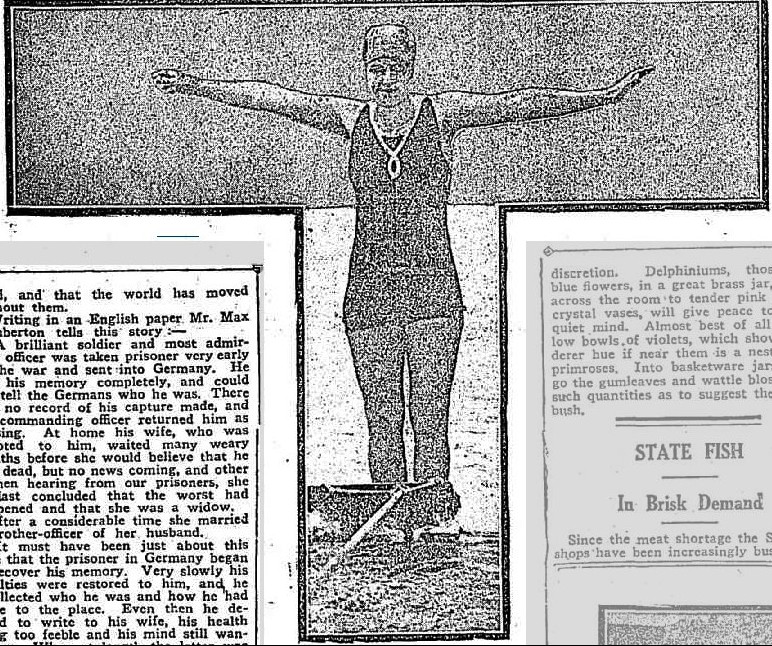
Yet this does not prevent her from tearing round the harbor on an aquaplane which is being towed behind a motor boat at 15 miles an hour. In her picture shown on this page Miss Letham on a board which is about 3ft long by18in. wide. Below her is the shark infested harbor, and it is only her nerve and her wonderful balance that keep her out of it. Miss Letham fell once or twice while learning the art of aquaplaning, her most disturbing experience being when she slipped off as she was passing Sydney Heads. Aquaplaning has not caught on with the girl swimmers of Sydney to any great extent. It is too dangerous, and the sharks arc so great a menace. Miss Letham, however, pronounces it the finest sport in the world, notwithstanding the fascination the sun has tor her. The Freshwater mermaid is eagerly anticipating the joys of Honolulu. No, she does not hunger for the sights and scenes of Hawaiian beauty. She says: 'Just as soon as the gangway is down when we arrive, I am off in a taxi for the breakers.' A SYDNEY SEA-GULL. (1918, August 18). Sunday Times(Sydney, NSW : 1895 - 1930), p. 13. Retrieved from http://nla.gov.au/nla.news-article123137676
 "DUKE'' KAHANAMOKU - The Hawaiian swimmer, the Olympic
100 Metre Champion, whose speed in the water is nothing short of marvellous.
"DUKE" KAHANAMOKU. (1912, November 23). Globe (Sydney, NSW : 1911
- 1914), p. 4 Edition: WEEKLY. Retrieved from http://nla.gov.au/nla.news-article98404629
"DUKE'' KAHANAMOKU - The Hawaiian swimmer, the Olympic
100 Metre Champion, whose speed in the water is nothing short of marvellous.
"DUKE" KAHANAMOKU. (1912, November 23). Globe (Sydney, NSW : 1911
- 1914), p. 4 Edition: WEEKLY. Retrieved from http://nla.gov.au/nla.news-article98404629
SWIMMING. DUKE KAHANAMOKU COMING. Duke Kahanamoku, the wonderful Hawaiian swimmer and champion amateur sprint of the world, will visit Australia during the next swimming season. Kahauamoku is the greatest sprint swimmer the world has known. His record for 100 yards being 55 l-5s. which was recently accomplished, but has not yet been passed. His figures for the 100 metres — 1min 1 ,4-5s— are phenomenal. Besides these records he is a marvel in the surf and his exhibitions here are looked forward to with keen interest by surf-lovers. SWIMMING. (1913, June 27). The Sydney Stock and Station Journal (NSW : 1896 - 1924), p. 15. Retrieved from http://nla.gov.au/nla.news-article124119511
DUKE KAHANAMOKU ARRIVES. Sydney, Monday. Duke Kahanamoku, the Hawaiian sprint swimmer, arrived in Sydney by the Sonoma to-day, accompanied by other Island swimming cracks. Telegrams. DUKE KAHANAMOKU ARRIVES. (1914, December 15). Leader (Orange, NSW : 1912 - 1922), p. 2. Retrieved from http://nla.gov.au/nla.news-article117886499
SWIMMING. SURF DISPLAY BY KAHANAMOKU. The New South Wales Swimming Association has arranged for a display by Duke Paoa Kahanamoku at Freshwater on Wednesday morning, at 11 o'clock. The famous swimmer will give an exhibition of breaker-shooting and board shooting. SWIMMING. (1914, December 22 - Tuesday). The Sydney Morning Herald(NSW : 1842 - 1954), p. 12. Retrieved from http://nla.gov.au/nla.news-article15554263
THE HUMAN MOTOR BOAT. DUKE KAHANAMOUKU'S WAY OFSHOOTING THE BREAKERSWONDERFUL WATER FEATS . HAWAIIAN IN HIS ELEMENT - There is one man only in Australia at the present time who can get aboard a breaker. He is Duke Kahanamouku, the human motor boat from Honolulu, one of the world's champion swimmers, who is in our midst now for the forthcoming swimming carnivals. Up till recently we had known him only by repute; we had seen him in picture in one of his famous attitudes — standing on his surf board, being borne shorewards on the crest of a wave, a smile on his dusky countenance, and there were a lot of us who imagined the poster to be grossly exaggerated; too theatrical, in fact. But we are wrong. The man on the poster is the Duke all right, but the picture errs on the side of modesty. It should have shown him balancing himself on his head on the board. This was one of the attitudes he struck at a private display of his wonderful surfing prowess given before a small gathering at Freshwater last Thursday morning. Nothing more remarkable in the way of a natatorial exhibition has ever been seen locally. Standing on the beach and looking seaward, all one could see was a towselled head, 300 or 400 yards away. It belonged to the Duke. As he rose on the next wave one could see his long dusky body stretched flat on his surf board, which was heaving and tossing like a cork on the face of the ocean. A moment or two later there was a wild whoop of joy from the Hawaiian native, who could be seen scrambling on to his knees. He got there at last, paddled frantically for a few yards, and then stood up. For the fraction of a second he poised, and then, giving the board beneath him a dextrous twist with his foot, shot over the surface of the water at a tremendous rate of speed. So lightning-like was the movement that all one could see was a dark figure— it might have been a post for all that the spectators knew — flying through space. A distance of 100 yards — a very small shoot for the Duke — took but a few seconds to traverse. What a picture he presented as he stood upright, the breakers curling beneath him, a smile on his face. Then he moved his feet again, and turning the board completely round, dived backwards into the boiling surf. A moment later his dark body glistening in the sun-light come to view again beside his precious board. And then the process was repeated all over again. The manner and rapidity with which Kahanamouku goes to sea on his board is truly marvellous. The board is 8ft. 6in. long, 2ft. wide, and three inches through at its thickest part. It reminds one of a coffin lid, the only difference being that it tapers at either end, more so at the front, however, in order to mount the breakers. A little more wood is left in the lower half of the board for purposes of stability. Its shellac surface is as slippery as a dancing floor, and altogether it weighs about70lb. It is not the Duke's private board, though, for it was made locally from sugar pine. Kahanamouku's own board is made of redwood, and is about 10lb. lighter, but he is immensely pleased with the local production, and says that after he has rubbed sand into its surface liberally that it will be equal to his own. Despite its great weight and awkward shape, the Duke shoulders his board jauntily until he reaches the shore. He gives it a hefty push, and throws himself flat on it. As soon as he gets into a foot of water he begins to work his arms, breast stroke — a method of propulsion that sends him out to sea about three times as quickly as a man swimming at his fastest rate of speed. Last Thursday some of the best local swimmers tried to keep pace with him, but he left them hopelessly behind. To balance himself on the board he simply places the left leg forward. The right is ten inches behind in a diagonal position. In such a posture he has complete control of the craft, and can, by using his feet, twist it in any direction he wishes. He can even wheel it round in the water like a flash. The best time to indulge in the sport, says Kahanamouku, is when there is a swell on the surface of the ocean, and when there is an almost complete absence of surf. It is then that the dusky native is seen in his most picturesque attitude — balancing himself on his head on the board, and allowing the waves to bear him shorewards. Under the same conditions the Duke performs another remarkable water feat. He takes a boy out to sea with him, and mounting his board allows the youngster to climb on to his back. In this fashion Kahanamouku and his passenger are brought in. Of course, it would be a rare occasion when he would be able to perform this feat round the Australian coast. Though there are dozens of natives at Honolulu who can ride a surf-board with almost the same dexterity as the Duke, not one of them can maintain his balance on the board and carry a passenger as well. Once one has become expert in this form of sport in the water he forsakes body surfing forever; why, it can readily be understood. It is faster in every respect, is not nearly so tire-some, and as for exhilaration, well there is the same difference as between cycling and motoring. Of course, there is a good deal of danger in the sport, especially if there be other swimmers in the vicinity. Provided, however, that various portions of the beaches round Sydney are set apart for the express purpose of surf-board riding, there is no reason why it should not become popular locally. After witnessing Kahanamouku's remarkable display last Thursday, one of the local swimming enthusiasts remarked, "I'm giving up surfing; I'm going to duck into the bush right now to search for apiece of bark;" and he wasn't the only one in the vicinity filled with the same ambitions.
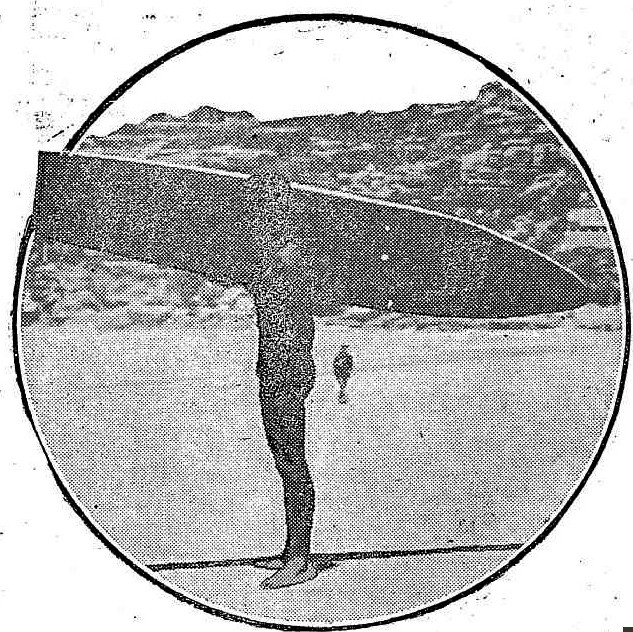
KAHANAMOUKU CARRYING THE IMMENSE BOARD ON WHICH HE CARRIES OUT HIS WONDERFUL WATER FEATS. It measures 8ft 6in by 2ft, is 3in through at its thickest part, and weighs over 70lb.
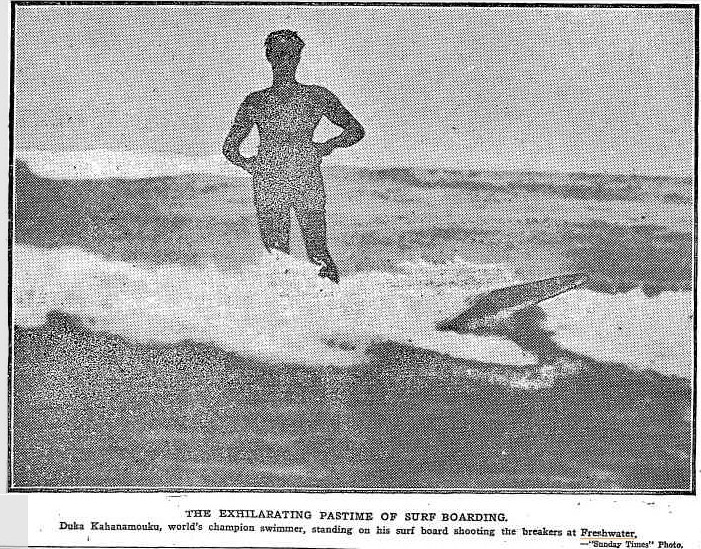
THE EXHILARATING PASTIME OF SURF BOARDING. Duke Kahanamouku, world's champion swimmer, standing on his surf board shooting the breakers at Freshwater. — "Sunday Times" Photo. THE HUMAN MOTOR BOAT. (1914, December 27). Sunday Times (Sydney, NSW : 1895 - 1930), p. 14. Retrieved from http://nla.gov.au/nla.news-article126760932
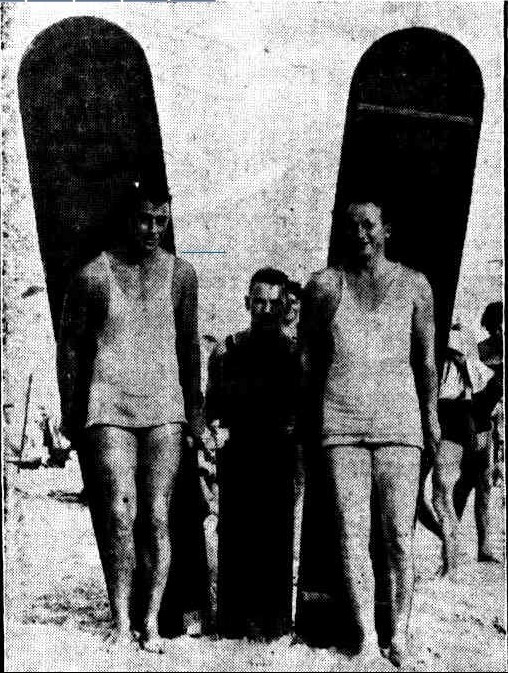
GIANT SURF BOARDS AT SCARBOROUGH: Two big surfboards of the type used at Sydney beaches were seen at Scarborough recently. The boards are eight feet long and weigh over 50lb. Lieut. R. R. McKissock, the Defence Department's physical training specialist, is on the left and Mr. E. Armstrong, the racing motorist, is on the right. GIANT SURF BOARDS AT SCARBOROUGH:. (1930, May 1).Western Mail (Perth, WA : 1885 - 1954), p. 23. Retrieved from http://nla.gov.au/nla.news-article38510459
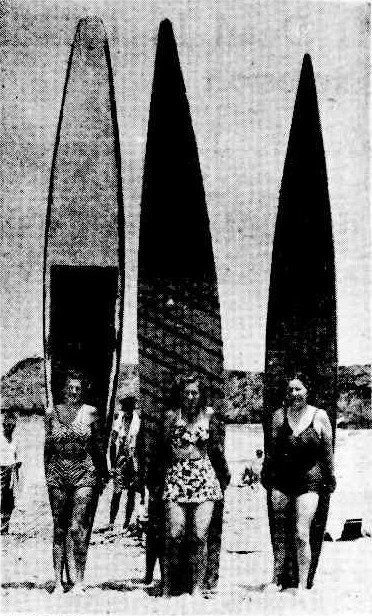
On The Beach At Torquay OUTSIZE SURF BOARDS for Miss Valerie Jewell, Miss Elaine Hill, and Mrs Nobby Clark, holidaying at Torquay. On The Beach At Torquay. (1946, December 30). The Argus(Melbourne, Vic. : 1848 - 1957), p. 6. Retrieved from http://nla.gov.au/nla.news-article22391466
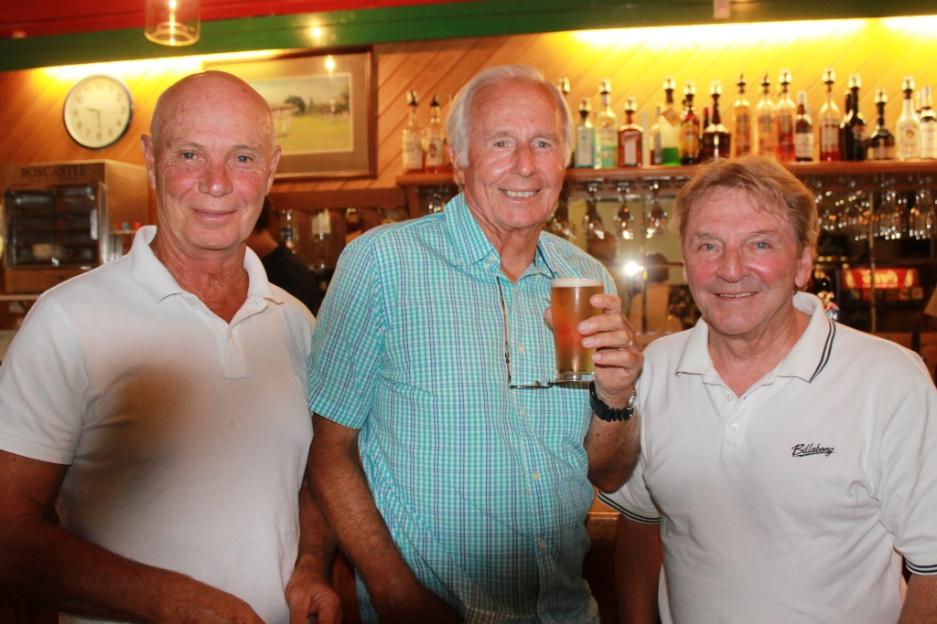
L to R: Kevin Dennis, Ken Mackey and Mick Dooley - surfing legends.
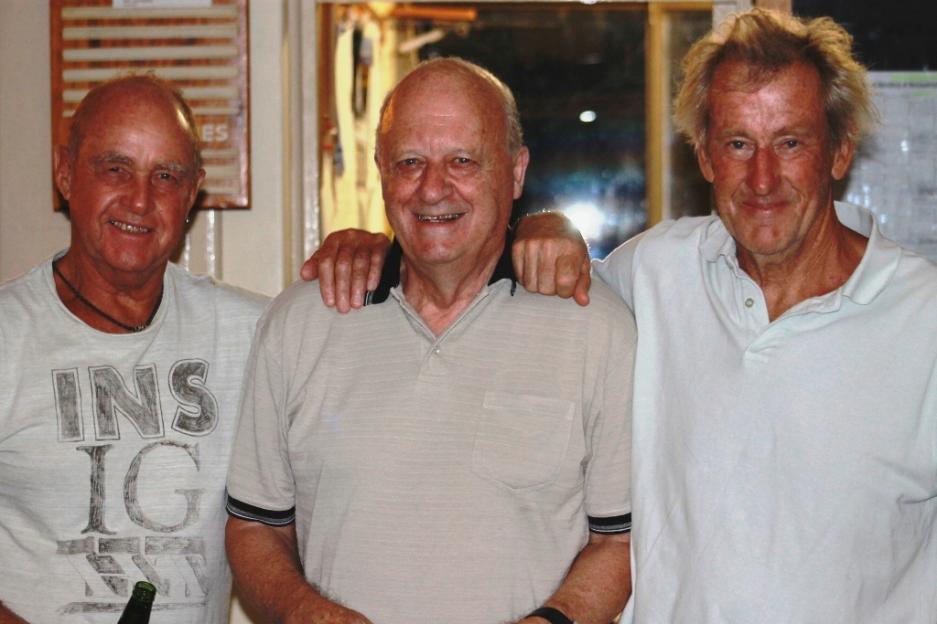
L- R: Steve Reynolds, John Stone and Robbi Luscombe-Newman.
Copyright David Lyall, Bob Head, Jack McCoy and ABHS, 2014. Article and ABHS Meeting Photos by A J Guesdon.